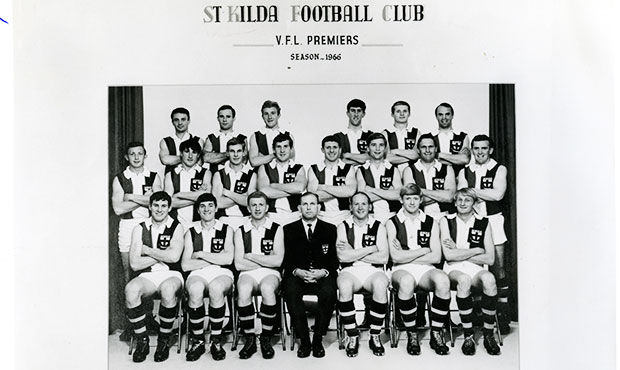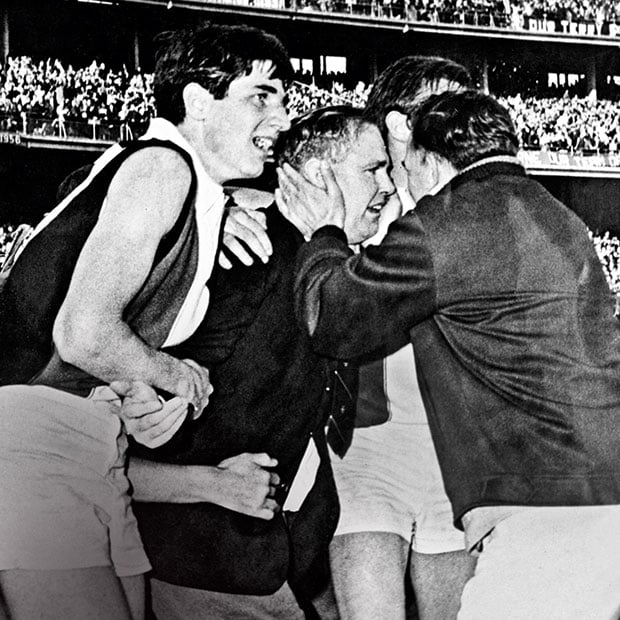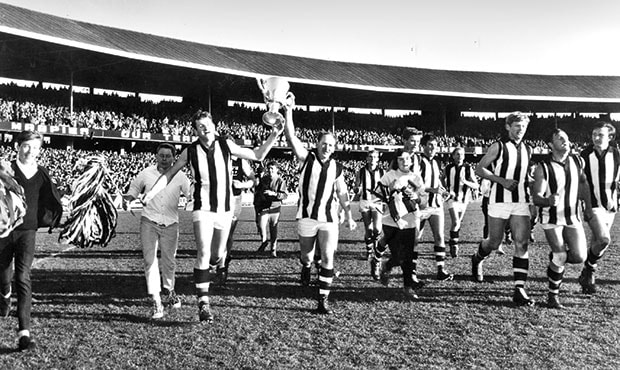Fifty years on, why is football still in love with the 1966 Grand Final?
There have been plenty of great Grand Finals over the journey, replete with all sorts of hits and memories.
Yet when the various TV broadcasters stage their 'Footy Marathons' the night before the Grand Final, the magnificent final quarter between St Kilda and Collingwood always features prominently.
It was a flag decider that ticked so many boxes.
It starts with the romance. It was the first premiership for the downtrodden St Kilda, a founding member of the then VFL in 1897 but by any measurement the worst-performing club in that time.
The Saints had a winning percentage of just 35 per cent between 1897 and 1966, a paltry return when compared with clubs such as Collingwood (65 per cent) and Carlton (59 per cent). The Saints had made just two Grand Finals before then, in 1913 and 1965. The 1966 finals series was just the 10th contested by the seaside club in 70 years.
So when St Kilda finally won the big one, and when you add in the dramatic circumstances of the one-point victory and that the opponent on the day was the hated Collingwood, you have a Grand Final that will always sit among the pantheon of the great ones.The thing about the Saints is that they have never polarised football fans in the way, say, Collingwood or Carlton traditionally have. We roll our eyes at some of the "only at St Kilda" moves they have made (courting and sacking Malcolm Blight within 10 months, letting Ross Lyon walk and moving to Seaford are some of the headliners), but we feel no disdain or malice towards the club.
Indeed, through its high-profile supporters, we have vicariously lived through the trials and tribulations of following the Saints. Back in 1966, it was Graham Kennedy, the biggest TV star of the day. Today it is the likes of Shane Warne, Eric Bana, 'Molly' Meldrum or music impresario Michael Gudinski. It was the Saints' fandom of the latter pair that featured prominently earlier this year in the two-part Molly TV series and the documentary that followed.
They are quirky people who follow a quirky club. And even though it is now 50 years, we still celebrate the one day that their club stood head and shoulders above the rest.
The 1966 St Kilda team.
Another reason why the 1966 Grand Final endures as it does is because of the media coverage that surrounded it. As St Kilda historian Russell Holmesby points out, it is the first flag decider that was telecast by Channel Seven to survive in its entirety. Football's modern broadcasting era started with the 1966 Grand Final.
There are snippets of other VFL Grand Finals before then. Scan through YouTube and you can find newsreel footage of earlier games or TV broadcasts of select quarters here and there.
But a mysterious fire at Channel Seven Melbourne (mysterious in the sense it was never reported) supposedly wiped out much of the station’s footy archive and the first Grand Final footage to survive intact was from 1966.
And for that we are truly blessed. There might not have been a Grand Final broadcast since that has contained more memorable lines.
Commentators Mike Williamson and former Fitzroy ruckman Alan 'Butch' Gale were at the top of their game while Ted Whitten demonstrated once again how comfortable he was with a microphone in his hand, even though he still had several more years to go as Footscray’s greatest player.
Some of the great lines have become part of the game's lore. "He was held," said Williamson in the second quarter of a contentious umpiring decision. "Jack Hill the blind miner could see that."
Who was "Jack Hill" and how did he work the mines if he was really blind? Saints fans and football historians have been asking that question for, well, 50 years.
The closer the game and the longer it went, so did the pressure build for everyone. And the better the commentary became, such as these gems from Williamson in the frantic final quarter: "I tipped this!"
Williamson first contemplated a drawn game in the second quarter and brought it up again in the dying moments before Barry Breen kicked that famous behind to give the Saints the lead.
"They have been playing … if my hand can stop shaking I can see my watch," and "I just put the lighted (sic) end of the cigarette into my mouth."
And from Whitten in the dying seconds, after a fine clearing mark from Saints defender Bob Murray. "Hit the boundary line!"
Channel Seven had a revolutionary four cameras covering the game, with the pictures threaded together by legendary director Alf Potter. It wasn't televised live into Melbourne, but Seven did cross live to the premiership cup presentation where Williamson waxed lyrical about the match and urged viewers to watch the replay, which started that evening at 6pm.
It wasn't the only footage of the match. Quite fortuitously, the BBC decided to travel to Melbourne to shoot a documentary and was given fantastic access to the clubs and the players.
One of the stars of the documentary was St Kilda defender Brian Sierakowksi, who was filmed relaxing in the lead-up to the game, including a water skiing outing (while having a beer!) on Port Phillip Bay.
The gregarious Sierakowski was the life of the party. His 1966 teammates still giggle at some of his antics. It was Sierakowski who issued a firm guarantee to his law lecturer at university and avid Saints fan, Zelman Cowen (later Sir Zelman Cowen, Governor-General of Australia), the week of the game that the Saints would win the flag.
Thanks to the documentary and the Channel Seven coverage, there is also great footage that still exists of the post-match celebrations in the St Kilda rooms at the MCG and of the celebratory dinner dance that evening at McClures, the well-known Melbourne restaurant of the time.
And there is even sound of coach Allan Jeans' three-quarter time address, reminding his players that they had "25 minutes to make a name for yourselves like you've never made before."
That they did.
Allan Jeans brought to tears in 1966.
About the only media outlet of the day that didn't seem to get caught up in the excitement was The Age. The only mention of football on the front page of the newspaper the following Monday was of former South Melbourne ruckman Ken Boyd being reported four times in the Ovens and Murray Grand Final, which was played the day before.
Indeed, the only time football broke through the vice-like grip that federal politics and world news had on the front page of The Age in the week before the game was a report confirming that centre half-back Ian Synman would definitely take his place for the Saints.
There was no doubt in Synman's mind that he would play, even though the match fell on Yom Kippur, the Jewish Day of Atonement. There has long been an apocryphal story that Synman, who was Jewish, sought the blessing of a rabbi to be able to play on what is the most significant and solemn Jewish holiday of the year.
No rabbi would ever give such a blessing and nor did the non-religious Synman ever ask. But the game was a factor for Melbourne's Jewish community, which at the time was largely centered only a couple of miles from the club's former home base at the Junction Oval.
A sad fact for many older Jewish Saints fans is that they were alive for their club's only premiership but weren't able to see it. In many cases they first learned of the result when rabbis interrupted their synagogue services to give the final score.
Not every Jewish supporter missed the game. Zelman Cowen was one of the 102,055 at the MCG and was later asked by one of his law students (not Sierakowski) whether it was worth giving up his religious duties for the day to be at the game.
"It's too soon to tell," was his answer, but given Sir Zelman lived until 2011 when he died peacefully at home, chances are he got away without incurring the wrath of anyone or any supreme being. As his son Ben told the AFL Record, "Presumably now he knows."
What was also notable about the 1966 Grand Final was the unfortunate sight of Darrel Baldock wearing a Collingwood jumper for the presentation of the premiership cup.
The Saints enjoy a lap around the MCG after defeating Collingwood in 1966.
It grates St Kilda people to this day that what should be the most iconic photo in the club's history features Baldock in black and white stripes, with the vanquished Collingwood skipper, Des Tuddenham, standing alongside him in a St Kilda jumper.
From all reports, Baldock was reluctant to swap jumpers, which was the post Grand Final norm in the day.
Indeed, Sun News Pictorial photographer Clive Mackinnon, a keen Saints fan whose collection of images from the day now belong to the club, urged Baldock not to swap jumpers for the sake of posterity, but the Saints skipper felt it was the right thing to do. As a result, the VFL ruled after that game that the winning captain was no longer permitted to swap jumpers.
Perhaps Baldock thought there would soon be other St Kilda premierships. Sadly, there haven't been and when the Saints were asked to wear their clash strips for the 2010 Grand Final and the next week's replay, it was arranged to have the regular home jumpers on standby in the rooms at the MCG so, if they did win, Nick Riewoldt and the team would have their images captured for time immemorial in the traditional garb.
Saints fans have been waiting 50 years for that next premiership money shot. The 17 players from 1966 who are still alive are ready not just to share the spotlight but are eager to hand over the mantle.
Those of us who are not St Kilda shake our head at the number of champion players who have passed through their doors since then – Trevor Barker, Tony Lockett, Robert Harvey and Riewoldt headline a very good group – and wonder why there hasn’t been a second premiership.
"I know some St Kilda people who have '1966 fatigue'," said 3AW broadcaster and Saints obsessive, Bruce Eva. "We've had so many great moments since then without winning the ultimate, it makes '66 look even more mythical."
What makes 1966 even more remarkable over time is in each of the subsequent Grand Finals played by the Saints, they were in a position to win. They led at three-quarter time in 1971, half-time in 1997, three-quarter time in 2009 and with only a few minutes to go in 2010.
They are tales of woe and remain the cause of misery for St Kilda supporters, who truly deserve to be called 'long-suffering', unlike Carlton and Richmond fans who have tried to muscle in on that adjective in recent years.
St Kilda's second premiership is well overdue. That much is indisputable. But for any football club, no premiership is more special than the first, and no first premiership in football history is better than that won by St Kilda in 1966.



